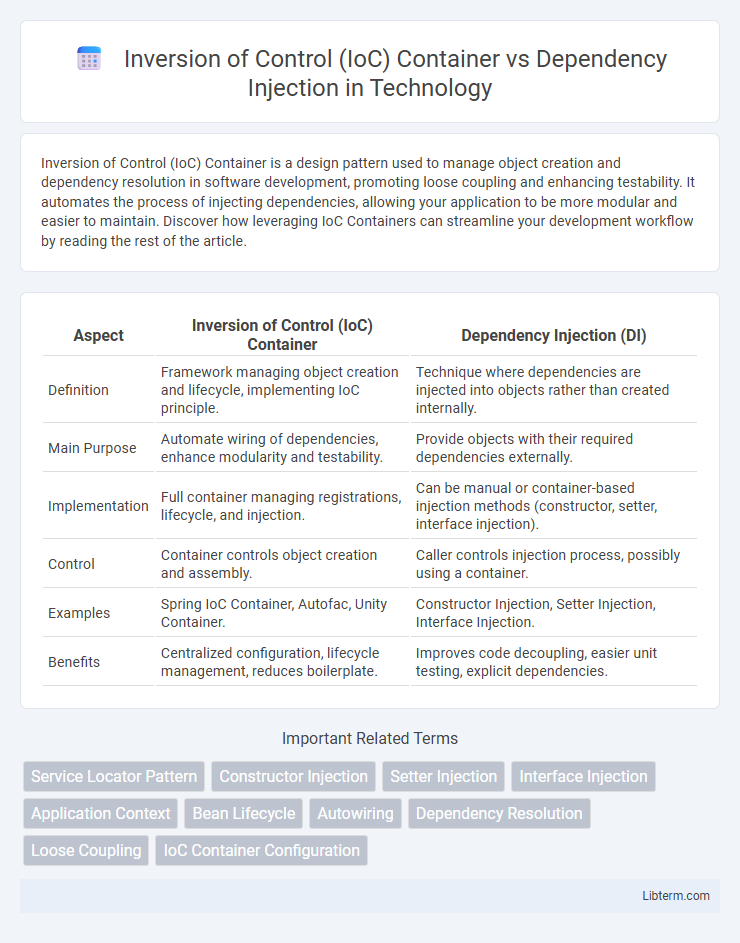Inversion of Control (IoC) Container is a design pattern used to manage object creation and dependency resolution in software development, promoting loose coupling and enhancing testability. It automates the process of injecting dependencies, allowing your application to be more modular and easier to maintain. Discover how leveraging IoC Containers can streamline your development workflow by reading the rest of the article.
Table of Comparison
| Aspect | Inversion of Control (IoC) Container | Dependency Injection (DI) |
|---|---|---|
| Definition | Framework managing object creation and lifecycle, implementing IoC principle. | Technique where dependencies are injected into objects rather than created internally. |
| Main Purpose | Automate wiring of dependencies, enhance modularity and testability. | Provide objects with their required dependencies externally. |
| Implementation | Full container managing registrations, lifecycle, and injection. | Can be manual or container-based injection methods (constructor, setter, interface injection). |
| Control | Container controls object creation and assembly. | Caller controls injection process, possibly using a container. |
| Examples | Spring IoC Container, Autofac, Unity Container. | Constructor Injection, Setter Injection, Interface Injection. |
| Benefits | Centralized configuration, lifecycle management, reduces boilerplate. | Improves code decoupling, easier unit testing, explicit dependencies. |
Introduction to Inversion of Control (IoC)
Inversion of Control (IoC) is a design principle where the control of object creation and dependency management is transferred from the application code to a container or framework, promoting loose coupling and enhanced modularity. An IoC container automates the instantiation, configuration, and injection of dependencies, streamlining application development and maintenance. Dependency Injection (DI) is a specific implementation of IoC, focusing on providing objects with their dependencies rather than creating them internally.
Understanding Dependency Injection
Dependency Injection (DI) is a design pattern that facilitates the decoupling of object creation and dependency management by injecting required components into a class rather than the class creating them internally. An Inversion of Control (IoC) Container is a framework that automatically handles object instantiation and injects dependencies based on configuration or annotations, streamlining the DI process. Understanding Dependency Injection involves recognizing how DI promotes modular, testable, and maintainable code by managing dependencies externally rather than hardcoding them within application logic.
Key Differences Between IoC Container and Dependency Injection
Inversion of Control (IoC) Container and Dependency Injection are related but distinct concepts in software architecture; IoC Container is a framework or tool that manages object creation and their dependencies, while Dependency Injection is a design pattern where an object's dependencies are provided externally rather than created internally. The key difference lies in scope: Dependency Injection is a technique to implement IoC, enabling decoupling and easier testing, whereas IoC Container automates the process by managing the lifecycle and resolution of dependencies at runtime. IoC Containers support various Dependency Injection methods such as constructor, setter, or interface injection, simplifying configuration and promoting modular, maintainable codebases.
How IoC Containers Work
IoC Containers automate the process of managing object creation and lifecycle by resolving dependencies at runtime based on configuration or annotations. They maintain a registry of component mappings and inject required dependencies into objects when they are requested, promoting loose coupling and improving modularity. By leveraging reflection or proxy mechanisms, IoC Containers control object instantiation, scope, and configuration without explicit code, streamlining dependency management and enhancing testability.
Types of Dependency Injection
Types of Dependency Injection include constructor injection, setter injection, and interface injection, each enabling different ways to supply dependencies to objects. An Inversion of Control (IoC) Container automates the process by managing object creation and dependency resolution, often supporting multiple injection types for flexibility. Constructor injection is the most common pattern, ensuring dependencies are provided at object instantiation for immutable and required components.
Benefits of Using IoC Containers
IoC Containers streamline the management of object lifecycles and dependencies by automatically instantiating and injecting required components, leading to improved code modularity and maintainability. They enhance testability by enabling easy swapping of implementations and reducing boilerplate code associated with manual dependency handling. By centralizing configuration and promoting loose coupling, IoC Containers significantly boost application scalability and flexibility in complex software systems.
Common IoC Container Frameworks
Common IoC container frameworks such as Spring, Google Guice, and Microsoft Unity provide robust mechanisms to implement Dependency Injection (DI), enabling automatic management of object lifecycles and dependencies. These frameworks facilitate constructor, setter, and interface injection, enhancing modularity and testability by decoupling component implementations from their consumers. Utilizing IoC containers streamlines configuration and promotes scalable application architectures by managing service registration, resolution, and scope effectively.
Practical Use Cases for Dependency Injection
Dependency Injection (DI) is widely used in software development to improve code modularity and testability by providing dependencies from external sources rather than creating them internally. Practical use cases for DI include managing service lifetimes in web applications, enabling seamless unit testing through mock dependencies, and facilitating configuration of complex object graphs in frameworks like ASP.NET Core or Spring. While an Inversion of Control (IoC) Container automates the instantiation and injection process, DI itself focuses on the design pattern that makes applications loosely coupled and easier to maintain.
IoC Container vs Dependency Injection: Which to Choose?
Choosing between an Inversion of Control (IoC) Container and Dependency Injection (DI) depends on the complexity and scale of the application architecture. IoC Containers automate the process of managing object lifetimes and dependency resolution, enhancing modularity and reducing boilerplate code, making them ideal for large, complex systems. Dependency Injection provides a more explicit and simple approach to passing dependencies, suitable for smaller projects or scenarios requiring fine-grained control over component creation.
Conclusion and Best Practices
Inversion of Control (IoC) containers streamline dependency injection by automating object creation and lifecycle management, enhancing modularity and testability. Best practices include favoring constructor injection to ensure immutability and explicit dependencies, avoiding service locator patterns that obscure dependencies, and configuring IoC containers with clear, maintainable scopes. Leveraging IoC containers properly improves code maintainability, reduces tight coupling, and supports scalable application architectures.
Inversion of Control (IoC) Container Infographic

 libterm.com
libterm.com